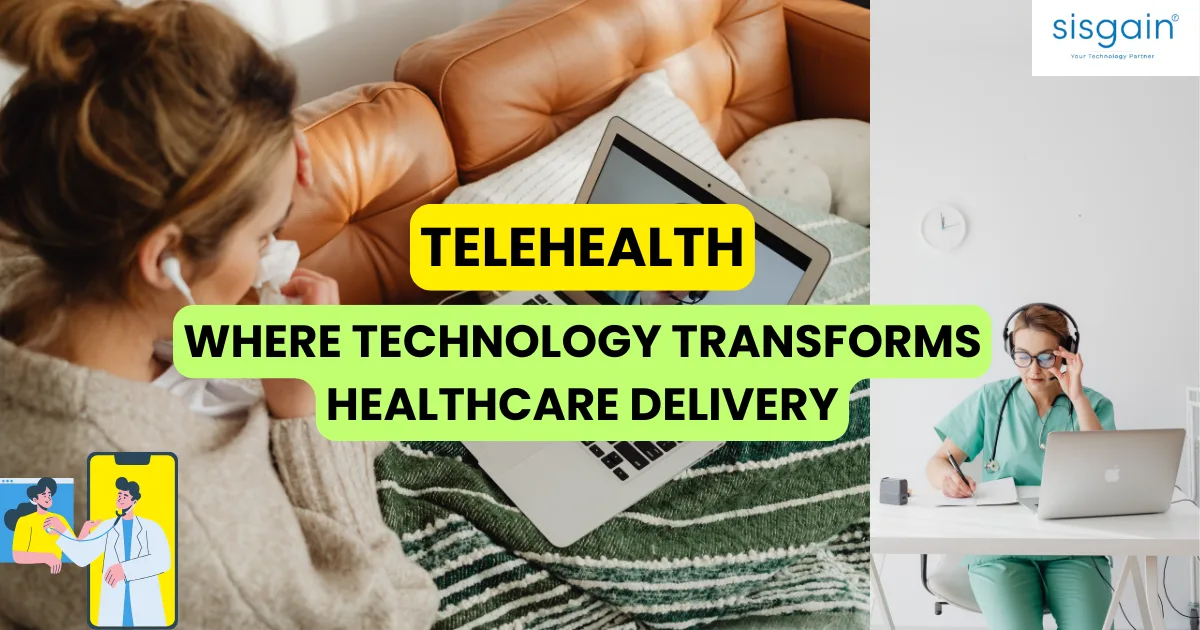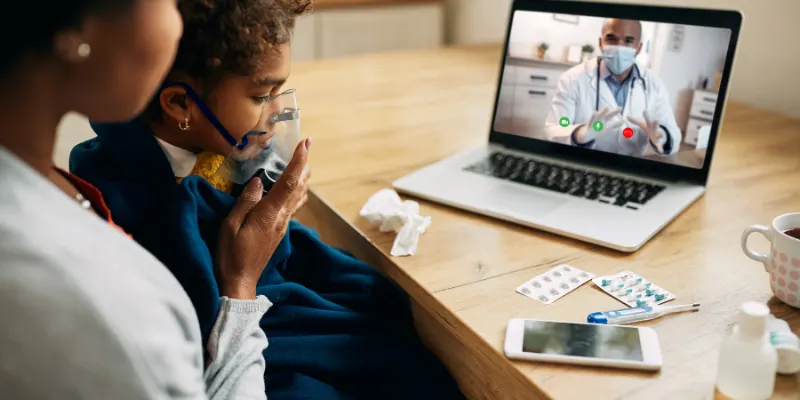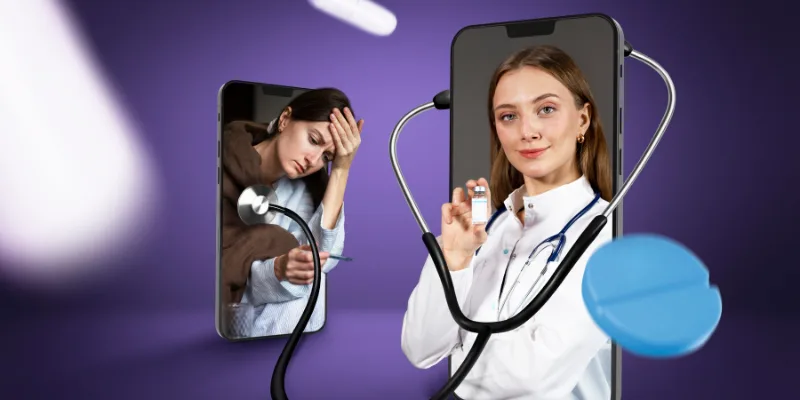Sales Team
Project quotes, partnerships, implementation

What if the future of healthcare didn’t require waiting rooms or hospital visits? With telehealth, that future is here - blending innovation and compassion to bring technology and healthcare together at your fingertips.
The combination of technology and health has revolutionized how medical services are delivered, making care more convenient, efficient, and patient-centered. As digital transformation spreads across the world, telehealth and telemedicine are at the forefront of redefining healthcare accessibility and innovation.
In this blog, we’ll explore what telehealth is, how it works, its benefits, technologies, and its role in shaping the future of healthcare delivery.
So, what is telehealth? Telehealth refers to the use of digital communication technologies - such as smartphones, video conferencing tools, and online platforms, to deliver healthcare services remotely. It allows patients to consult with healthcare professionals, receive diagnoses, and even manage treatments without visiting a hospital or clinic in person.
The telehealth meaning goes far beyond a simple video chat with your doctor. It represents a modern healthcare approach designed to make medical services more accessible, efficient, and personalized. Telehealth includes a wide variety of services, such as:
Telehealth appointments for virtual medical consultations
Remote monitoring of chronic conditions
Online healthcare education for patients and professionals
Digital prescriptions and easy follow-up sessions
E-health systems that enhance hospital workflows and data management
By using telehealth platforms, virtual visits, or telehealth apps, patients can access expert medical care from any location, bridging the gap between technology and health while ensuring quality, convenience, and timely treatment.
Many people use the terms telehealth and telemedicine interchangeably, but they have distinct meanings.
Telemedicine focuses specifically on clinical services such as diagnosing, treating, and managing illnesses remotely using digital communication tools.
In contrast, telehealth is broader. It includes telemedicine as well as non-clinical services like patient education, health administration, and training.
Over the last decade, technology in healthcare has rapidly evolved. Hospitals have shifted from paper records to digital health systems, and doctors use advanced medical technology to diagnose and treat patients faster and more accurately.
Electronic Health Records (EHRs): Secure cloud-based medical data storage.
Artificial Intelligence (AI): AI-powered diagnostic tools and predictive analytics.
Wearables and IoT: Real-time health tracking through connected devices.
E-Health Platforms: Virtual education and wellness programs.
The rise of digital health and telehealth technology has created a seamless link between tech and health, empowering both doctors and patients with real-time communication and data-driven insights.
How Does Telehealth Work?
A telehealth appointment typically involves several simple, technology-driven steps that make healthcare convenient and efficient.
Booking: Patients schedule a telehealth visit using an app or telehealth platform.
Consultation: The patient connects with a healthcare provider through secure video or audio call.
Diagnosis: The doctor reviews the patient’s condition and provides a diagnosis or recommendation.
Prescription: Digital prescriptions are sent to the patient’s chosen pharmacy.
Follow-up: Ongoing care or monitoring is continued virtually through the same system.
By removing the limitations of distance and time, telehealth care ensures quick, reliable, and accessible medical support for all.
Modern telehealth platforms form the backbone of this digital healthcare system. They integrate various telehealth technologies and healthcare IT services to deliver secure and efficient remote healthcare experiences.

High-Speed Internet: Enables smooth HD video calls and real-time data exchange.
Cloud Computing: Stores and manages patient data securely.
AI and Machine Learning: Helps in early diagnosis and predictive analytics.
IoT Devices: Smartwatches and sensors track vitals continuously.
Blockchain: Ensures security and transparency in data sharing.
Together, these innovations have created scalable and dependable telehealth solutions that make healthcare more inclusive and intelligent.
Here are some common telehealth examples that illustrate how this technology is applied in daily healthcare operations:
Tele Doctor Consultations: Patients can speak to certified physicians through video calls for diagnosis and prescriptions.
Remote Patient Monitoring: Devices like glucose monitors and ECG trackers send data directly to doctors.
Virtual Mental Health Sessions: Psychologists and counselors provide therapy online.
E-Health Education: Hospitals conduct webinars and training for both patients and professionals.
Telemedicine for Rural Areas:Telemedicine platforms connect remote patients with specialists in urban hospitals.
These telehealth services are making medical care more personalized, accessible, and efficient.
The advantages of telehealth extend to both patients and healthcare providers. Below are some key benefits that highlight how telehealth improves access, efficiency, and overall care delivery for everyone involved.
Convenience: Schedule telehealth appointments anytime, anywhere.
Affordability: Reduced travel, hospital, and waiting costs.
Accessibility: Connect with top specialists regardless of location.
Continuity of Care: Maintain consistent treatment plans through virtual check-ins.
Safety: Receive care while avoiding hospital exposure risks.
Increased Efficiency: Serve more patients without physical constraints.
Data Management: Digitized records streamline workflows.
Patient Engagement: Regular reminders and follow-ups improve compliance.
Cost Savings: Lower operational expenses and administrative burdens.
By merging health and technology, telehealth is transforming healthcare into a more convenient and cost-effective experience for everyone involved.
The use of telehealth in healthcare is expanding globally. From large hospitals to small clinics, telehealth systems are now integral to medical operations.
Chronic Disease Management: Regular remote monitoring for diabetes or hypertension.
Postoperative Care: Virtual follow-ups after surgeries.
Behavioral Health: Therapy and counseling through virtual consultations.
Primary Care: Quick and efficient telehealth visits for minor illnesses.
Preventive Care: Health screenings and awareness sessions online.
These applications demonstrate how telehealth in healthcare improves outcomes and reduces unnecessary hospital visits.
Telemedicine in healthcare focuses on clinical treatment through technology. It is the backbone of telehealth, providing access to doctors and specialists without physical presence.
Patients can book appointments, share medical reports, and consult healthcare professionals via telemedicine platforms. This digital model ensures that patients receive diagnosis, prescriptions, and ongoing treatment remotely.
Telemedicine technology has become essential for hospitals, especially during pandemics and emergencies, as it ensures care continuity while minimizing in-person contact.
Virtual consultations have become an integral part of telehealth services. Patients now interact with doctors online just as they would in a clinic, discussing symptoms, reviewing test results, and getting medical advice.

Wearable devices and mobile apps enable remote health care by continuously monitoring patient data such as heart rate, blood pressure, and glucose levels.
Doctors can track this information in real time and respond quickly to changes in the patient’s health status.
This blend of virtual health and digital health improves patient engagement and ensures preventive, proactive care.
Behind every efficient telehealth appointment lies a robust network of telehealth systems and healthcare IT services that manage communication, data, and security.
Secure Video Conferencing: For safe and reliable doctor-patient interactions.
Data Encryption: To ensure patient privacy and HIPAA compliance.
Integrated EHR Access: To simplify patient history retrieval.
Automation Tools: For scheduling, billing, and reminders.
These systems make telehealth care smoother, faster, and safer - empowering doctors and patients alike.
Despite its many advantages, telehealth technology faces certain challenges:
Internet Access: Limited connectivity in rural regions.
Privacy Concerns: Need for stronger data protection.
Regulatory Differences: Licensing requirements across borders.
Digital Literacy: Some patients find it hard to use new tools.
However, as governments and healthcare organizations adopt better telehealth solutions, these barriers are slowly being eliminated.
The future of telehealth in healthcare is bright. With advancements in AI, IoT, and 5G, telehealth will soon offer more precise, predictive, and personalized care.
AI-based diagnostics for faster detection of diseases.
Virtual reality for patient rehabilitation.
Blockchain integration for transparent data management.
Wearable IoT devices for continuous monitoring.
Automation and Chatbots for appointment scheduling.
These developments will make telehealth technology smarter, creating a healthcare ecosystem that’s connected, efficient, and accessible to all.
The digital age has given rise to a new model of healthcare - one that’s driven by innovation, connectivity, and patient convenience. Telehealth stands at the center of this transformation, reshaping how care is delivered across the globe.
From virtual consultations to remote monitoring, telehealth ensures accessibility, efficiency, and quality care - anytime, anywhere.
As a leader in digital healthcare innovation, SISGAIN empowers hospitals, startups, and clinics with advanced telehealth and telemedicine applications. By combining smart healthcare IT services with next-generation technology, SISGAIN continues to revolutionize remote healthcare and shape the future of digital health worldwide.
Project quotes, partnerships, implementation
Open roles, referrals, campus hiring